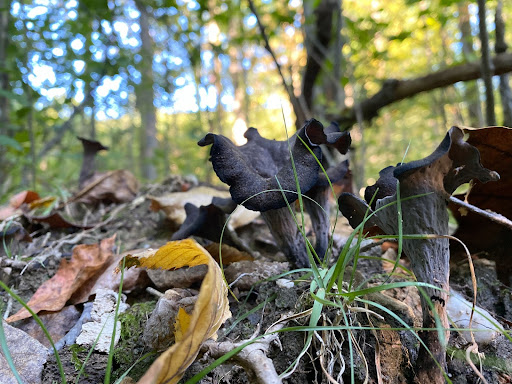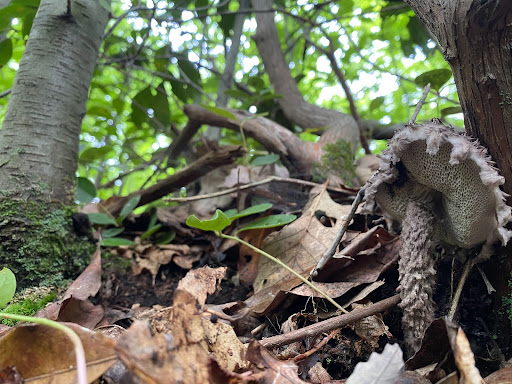We’ve reached the depths of summer, as evidenced by intense waves of heat and humidity.
Solace from our powerful sun awaits beneath the shade of trees, and lucky for us, interesting organisms exist there too. Mushrooms occupy the forest floors throughout the year, but in late summer – and even more so in early fall – they become particularly abundant. So much so that running into truly bizarre and charismatic species can be as simple as seeking out a cool place to relax and looking down.
Here are a few mushrooms to look out for as summer ensues and fades into autumn.
Click here to learn more about our upcoming members-exclusive Mushroom and Salamander Hike at Hart’s Woods.
Remember, some mushrooms are poisonous, and there are look-alike varieties that may be harmful or even deadly for consumption. Also, some people are allergic to mushrooms that most people have no problem eating. Forage carefully! This article is meant to be informational only.
Black Trumpet (Craterellus fallax)

Black Trumpets are the smallest mushrooms we’ll cover, so they can be challenging to spot. They only grow a few centimeters in height and are easily overlooked amongst vegetation and leaf litter on the forest floor. Their common name references the mythology that their trumpet-shaped fruiting bodies are connected to deceased beings – perhaps musicians? – buried underground.
Black Trumpet is believed to be both mycorrhizal (symbiotically connected to roots of plants) and saprotrophic (feeding on dead organic matter), but their ecology isn’t entirely understood.
I often find them in association with two natural features: oak trees and mossy areas near oak trees. That isn’t to say you won’t find them in mossless areas near other tree species, but you may increase your chances of finding some if you hone in on those cues. They are considered to be one of the better tasting mushrooms, even though their appearance might not sell that point very well.
I enjoy hunting for this mushroom simply because of the difficulty in spotting them, as well as their association with my favorite group of trees.
Old Man of the Woods (Strobilomyces strobilaceus)

A great common name, a truly odd appearance, and the challenge associated with finding them make Old Man of the Woods a beloved mushroom species among Fungi enthusiasts.
This species is a member of the Bolete family, which is a group of mushrooms often sought after for their edibility – though some are considered underwhelming, and others are poisonous. Despite their shaggy, alien-like appearance, Old Man of the Woods is considered to be edible and some foragers have even described them as being tasty.
They form mycorrhizal connections with the roots of hardwood trees, and they’re often found in association with – you guessed it – oaks. They don’t often form large clumps, but rather sprout up individually in small numbers. This contributes to the joy of running into this species, as it can often feel like a “right time, right place” kind of scenario.
Old Man of the Woods is truly bizarre looking and one of my favorites to find during the summer and early fall.
Chicken of the Woods (Laetiporus sulphureus)

This often obvious, vibrant, and delicious mushroom is perhaps the most well known of the bunch discussed in this article.
Found in a variety of habitats, the Chicken of the Woods is a saprotrophic and sometimes parasitic fungus. By saprotrophic, I mean they find nourishment from decaying organic material, but they can also feed on live trees, making them parasitic in some instances.
This species is popular because it is a choice edible mushroom, but the mushrooms are also admired for their large and stunning appearance. They can be found growing out of a number of tree species, both live and dead, and standing or fallen. I’ve often found them in association with different oaks and black cherries. Their affinity for already dead or dying trees highlights their importance as recyclers, as they break down wood and return nutrients to other organisms that dwell in the forest.
There’s actually more than one species of Chicken of the Woods, but Laetiporus sulphureus (pictured above) seems to be more frequently encountered than some of the others.
While Chicken of the Woods is edible, they can be mistaken for less than savory and even toxic species. Extreme caution should be taken before foraging for this species. One of its common lookalikes is the Jack-o-lantern mushroom (Omphalotus olearius), which is indeed poisonous. The way to distinguish between the two is to look underneath the mushroom: Chicken of the Woods has tiny pores on its underside, whereas Jack-o-lantern mushrooms possess slits or gills underneath. Out of all of the mushrooms I’ve foraged, Chicken of the Woods is hands down the most delicious. An aptly named species, no doubt.
These species represent a tiny fraction of the mushrooms waiting to be found this summer. The transition period between summer and fall offers some of the best opportunities for mushrooming, so there’s still plenty of time to get out and find some interesting fungi for yourself.
Thanks for reading, and happy mushrooming!
Sebastian Harris, Conservation Easement Steward
Curious about pollinators, turtle crossings, reforestation and other woodsy things? Read more Nature Notes.